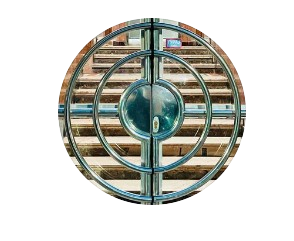This guide is about a style and how it shaped the everyday architecture of Belgrade. It is not a list of famous landmarks or grand architectural statements. Instead, it invites you to notice something quieter and more personal: the front doors of residential buildings from the late 1930s and early 1940s.
In this guide, doors are the starting point. This is where style often reveals itself most clearly - in the proportions of the portal, the shape of the handles, the choice of materials, the geometry of glass and metal. An architect might design a building to be restrained and functional, but the door was a place to show personality and taste, often reflecting the broader architectural direction of the time.
Streamline moderne in Belgrade doesn't announce itself loudly. These buildings are not marked with plaques, not included in tourist routes, and not officially protected. Yet their doors quietly shape the look and feel of entire neighborhoods.
This guide helps you explore that visual language. It offers a way to see the city from street level, to slow down, and to recognize architectural beauty in the places you pass every day.
This guide is based on an interactive map featuring locations with streamline moderne doorways. It’s not a fixed route or a tour with a beginning and end - it’s an invitation to explore the city on your own terms. You decide where to go, how many doors to see, and where to start.
Open the map. You’ll see markers with photos. Choose an area that interests you. Tap on a marker to view a photo of the door and its exact location. Some locations can be easily combined into short walking routes. Others are scattered across the city, but they might lie along your everyday paths. It’s enough to open the map while you’re out and about.
This guide isn’t meant to be rushed. Even one door a day can become an act of architectural observation. Let your journey through streamline moderne be a personal walk through the city’s overlooked details.
Streamline moderne is an architectural and design style that emerged in the early 1930s in the United States as a response to the Great Depression, technological advancement, and a shift toward visual simplicity. It evolved from Art Deco, rejecting its ornamental excesses in favor of smooth lines and an industrial aesthetic.
Its primary sources of inspiration were speed and machinery. Designers borrowed shapes from ocean liners, trains, automobiles, and airplanes - symbols of modernity, progress, and functional beauty. The style spread beyond architecture into industrial design: radios, refrigerators, cars, and even irons were produced with similar visual features.
Key elements of the style include rounded corners, elongated horizontal lines, ribbon windows, smooth stuccoed facades, and glass or metal accents. Decoration is minimal or entirely absent. The style emphasizes rationality, speed, and modernity.
The first streamline moderne buildings appeared in the U.S. in the early 1930s. These were primarily transportation and commercial structures - train stations, car dealerships, gas stations, exhibition pavilions, shops, and cinemas. They were designed to be seen from the street or road, acting as advertisements and symbols of hope and momentum. Over time, the style found its way into residential architecture. In apartment buildings, it was most visible in facade treatments: soft curves, horizontal windows, nose-like balconies, restrained color palettes, and little to no decoration.
In Belgrade, the style appeared mainly in this form - as a design language for residential buildings constructed in the late 1930s and early 1940s. It’s usually noticeable not in the entire composition, but in specific elements like balconies, stairwell windows, and doors. In Belgrade, streamline moderne is rarely treated as a distinct style. It’s often seen either as the final phase of Art Deco or a transitional stage toward modernism. As a result, it often escapes notice - even though its elements are scattered across the city, especially if you look not at entire facades but at architectural details like entrances.
Streamline moderne was one of the last decorative movements before the shift to postwar functionalism. Despite its restraint, it retains a distinct identity and value as a visual code of its era.
The second half of the 1930s was a period of rapid urban development for Belgrade. The city was expanding quickly - new streets, neighborhoods, and building types were emerging, and its overall appearance was changing. Along with that came a shift in architectural preferences: historical styles and decorative Art Deco gradually gave way to simpler, more rational forms.
Streamline moderne appeared in Belgrade as part of a broader transition toward modernism. It served as an intermediate phase between ornamental aesthetics and strict functionalism. While it was never the official or dominant style, it was widely used, especially in the construction of multi-family housing for the middle class. These new apartment buildings were meant to be modern, comfortable, and in tune with the spirit of the times. And the streamlined forms and restrained geometry of the style captured that ambition well.
The style was most visible in neighborhoods developed during the prewar years - such as Vracar, Dorcol, Palilula and parts of Savski Venac. In these areas, entire streets are lined with buildings that feature elements of streamline moderne. At the same time, the style had little influence on official architecture, as government and representative buildings were still largely constructed in academic or monumental modernist styles.
The Belgrade version of streamline moderne is generally modest. It is not a showy style, but rather a local adaptation of international architectural trends. There is less glass and metal than in Western examples, but the key elements remain - horizontality, rounded corners, and geometric order. These are most clearly expressed in the design of building entrances.
In Belgrade architecture streamline moderne is most often expressed not in the overall composition of a building, but in the details, especially in the entrances. Doors and entry vestibules are where the style becomes most recognizable and where its aesthetic is most clearly felt. The contrast between restrained facades and richly designed interiors is one of the defining characteristics of the Belgrade version of this style.
- transparent or semi-transparent glass panels, often in one continuous piece
- a clearly defined metal frame with geometric patterns - rectangular, diagonal, or radial
- bold chrome handles, sometimes in custom shapes
- a strong sense of symmetry and compositional discipline
- occasionally, recessed entryways or integrated light fixtures above the door

This contrast reflects a dual intent. The facade had to appear modern, rational, and understated, in tune with the spirit of the era. But the vestibule served a representational role. It was where residents and guests entered, forming their first impression of the building. Here, architects allowed themselves more expressive freedom and used higher-quality materials.
Common features include:
- mosaic or marble floors with geometric patterns
- walls clad in richly colored marble - green, burgundy, or pink
- decorative plasterwork, niches, mirrors
- carefully designed metal railings with flowing lines or rhythmic geometric motifs

Facades are smooth and rounded, with curved corners, ribbon windows, and projecting bays. Horizontal lines dominate, making the buildings appear stretched along the street. Balconies often resemble the front of a ship - a nod to the style’s connection with speed and modern technology.
Exteriors are usually finished in dark, smooth plaster. Materials like glass, chrome, and marble are used more inside than outside. You’ll see marble in vestibules, chrome details on mailboxes, and glass panels in stairwells. This contrast between a modest exterior and a more refined interior is one of the unique features of Belgrade’s version of the style.

Just a few years later, he opened his own firm called “Neimar,” through which he completed over 70 buildings in Belgrade - an impressive number in such a short pre-war period. His work blended decorative Art Deco with restrained modernism, and his entrances stood out in particular. In these details, Bjelović struck a fine balance between utility and expressiveness: geometry, metal, glass, and carefully calculated proportions gave each building a strong character.
After the war, he continued working - first for the Ministry of Construction, and later in several construction companies, including Neimar, where he served as technical director. When the wave of nationalization began, Bjelović emigrated to Brazil. In São Paulo, he started over: he founded a new firm called “Ne-imar” and designed both residential and public buildings, adapting to a new context without losing his architectural identity.
Despite his emigration, Bjelović’s contribution to Belgrade’s pre-war architecture is hard to overstate. His entrances - simple, elegant, and precisely proportioned - can still be found across the city and remain an important part of the visual language of the era.
Momčilo Belobrk was one of the most distinctive representatives of Belgrade’s Art Deco and streamline moderne. He began his career at the architectural studio of Đura Borosic, one of the leading prewar modernists in Belgrade. It was there, surrounded by talented young architects, that Belobrk developed his vision of architecture as a synthesis of function and expression.
He paid particular attention to entrance design. For Belobrk, the entrance was more than just a technical element - it was a visual focal point, a way to express the spirit of the era. He designed unique glass-and-metal doors with geometric motifs and concentric chrome handles. These details reveal his intent to merge decoration with clean lines.
By the 1930s, Belobrk was working independently. His projects found a balance between restraint and ornamental expression. He made extensive use of modern materials like glass, metal, and ceramic tile. Entry halls often featured marble, mirrors, and custom-designed railings creating a theatrical spatial experience from the very threshold.
Belobrk was also one of the first Belgrade architects to sign his buildings: a small plaque with his name often appeared near the entrance, emphasizing the author’s personal identity and design approach.
His work reflects the evolution of Belgrade architecture from decorative Art Deco toward more functionalist forms. Even when budget constraints required simplicity, he found ways to express artistry through detail.
A member of the so-called “Paris circle” of Serbian architects, Branislav Marinković studied and worked in France in the late 1920s. He graduated from the École des Beaux-Arts in Paris and interned at several prominent French architectural firms, including that of Éric Bagge. This experience shaped him as a designer who embraced modern styles while maintaining a connection to national architectural traditions.
Marinković aimed to synthesize modernity and ornament. His buildings were balanced and reserved, yet subtly artistic. He avoided the bold formalism of high Art Deco in favor of calm facades and refined detailing. Even in competition projects like “Terasa Terazije,” he used expressive forms with moderation, emphasizing layered surfaces and visual harmony.
Join us on a daily door exploration!
Any copying and reproduction of text, photos and/or graphic materials, including partial and in any forms,
without the written permission of the copyright holder is prohibited.




















